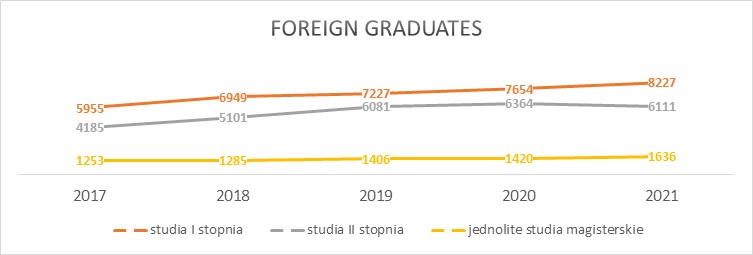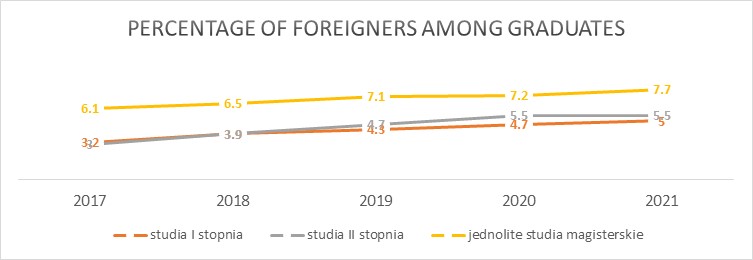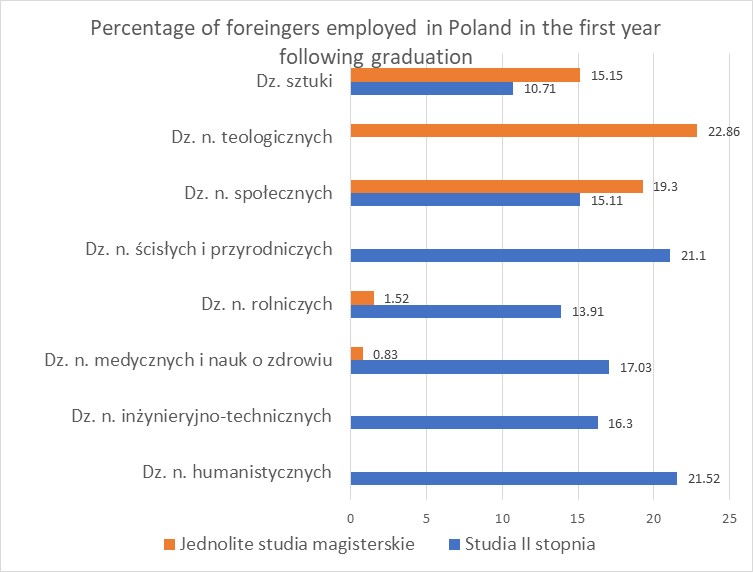
Polish universities’ efforts to promote internationalisation have led to a boost in the number of foreign students who graduate in Poland. With access to data from the Polish Graduate Tracking System (ELA), it is possible to evaluate the proportion of foreign graduates who have opted for employment opportunities in Poland and the extent of their early career success.
Data from the eighth edition of the ELA system reveals a rise in the number of international students who graduated in Poland. In 2021, the largest group of foreign graduates comprised those who pursued first-cycle programmes. Although second-cycle graduates remained the second most numerous group, their number decreased. A rise in the number of graduates who embark on long-cycle master's programmes marked a divergent trend.
 Figure 1. Foreign graduates
Figure 1. Foreign graduates
The shares of foreigners among graduates of the three types of study programme also followed upward trajectories. In 2021, the numbers of first- and second-cycle graduates rose by 5% individually, as opposed to slightly over 3% in 2017. The percentage was considerably higher among graduates of long-cycle master's studies: foreigners in that group accounted for 8% of the total graduate population.
 Figure 2. Percentage of foreigners among graduates
Figure 2. Percentage of foreigners among graduates
Differences in and changes to the proportions of foreigners varied widely across fields and types of study (first-cycle, second-cycle, and long-cycle master's programmes). The largest shares of foreign first- and second-cycle graduates majored in the arts or the social sciences; however, in neither domain did they exceed 10% of the total. The quantitative data that pertains to graduates of long-cycle master's studies was more nuanced. The largest group of foreign graduates had pursued medical programmes. That group comprised graduates whose countries of origin were uncommon for other groups (this had also been demonstrated in previous ELA analyses). The majority of foreign graduates of medicine in Poland originated from the United States, Norway, or the United Arab Emirates, where studying is much more costly than in Poland. In 2021, foreigners accounted for over 17% of graduates of medicine (medical doctors and dentists). The least numerous group of foreign graduates who engaged in long-cycle master's programmes majored in the social sciences, which encompasses law and psychology. Those fields attracted moderate interest due to their strong dependence on the Polish context—law students risk a narrow range of career options, each of which is connected deeply to Poland’s legal system, and in which graduates’ professional practice is governed by rigorous Polish regulations.
ELA data suggests that the shares of foreign alumni who were employed one year following their graduation varied considerably by field of study, and were markedly lower in each case than those of graduates of Polish origin.
The largest share of foreign graduates of long-cycle master's programmes who pursued careers in Poland had majored in theology. Slightly less represented groups specialised in social sciences and arts. Of foreign graduates who majored in the domain of medical and health sciences, 1%—along with 1.5% of those who obtained their degrees in agriculture—opted to pursue their careers in Poland.
Of all graduates of second-cycle programmes, the largest percentage of professionally active foreigners had majored in exact and natural sciences, or in the humanities.
Foreigners in the labour market (second- and long-cycle master's programmes)
 Figure 3. Percentage of foreingers employed in Poland in the first year following graduation
Figure 3. Percentage of foreingers employed in Poland in the first year following graduation